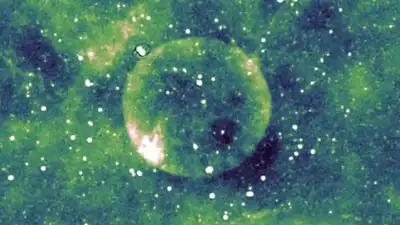
Teleios (Image source: Earth.com)
Scientists are puzzled by the discovery of a perfectly spherical object floating in the
Milky Way
, which emits only radio signals. Named
Teleios
, this strange structure does not give off visible light, infrared glow, or detectable X-rays, only faint radio emissions. The discovery defies simple explanations and raises questions about how such a perfectly round object could exist in space.Teleios first drew attention when scientists observed a circular region emitting subtle radio waves, despite showing no signs of light or heat. The object was discovered by a team led by Professor Miroslav D. Filipović of
Western Sydney University
, using data from Australia’s ASKAP (Australian Square Kilometre Array Pathfinder) telescope.
Strange sphere, Teleios found in the Milky Way
Although located within our galaxy, Teleios is completely invisible to the human eye. It lies thousands of trillions of miles from Earth, yet its radio signals traveled all the way to our telescopes. According to Earth.com, experts believe Teleios has a low surface brightness; its soft radio glow was detected during an all-sky survey carried out by ASKAP.
Its remarkable symmetry is challenging scientists to reconsider common assumptions about space structures. Based on the radio data, scientists estimate Teleios could be up to 157 light-years in diameter. While some researchers believe it might be the remnant of a long-ago stellar explosion, its smooth, round shape has also led to speculation that it could be a young supernova remnant or a more mature structure. What scientists do agree on is that Teleios lies in a remote, quiet region of space, expanding silently and standing out due to its near-perfect symmetry. As one researcher noted, “This unique object has never been seen at any wavelength, including visible light
Is Teleios a supernova
Some members of the research team suggest Teleios might be a massive bubble formed by stellar winds, but they can't rule out the possibility that it’s an expanding cloud of gas and dust left behind after a star exploded.Teleios has only been detected in radio wavelengths, which are the longest waves in the electromagnetic spectrum. This highlights the important role of radio telescopes in spotting rare cosmic objects that would otherwise go unnoticed by human eyes or regular optical instruments.The debate continues. Some scientists believe a white dwarf may have caused the explosion, slowly gaining mass far from crowded star clusters. Others think Teleios may have exploded in a quiet, outer part of the Milky Way, where fewer stars and less gas allowed it to expand in a smooth, undisturbed way.One theory proposes that the star blew away surrounding material before it exploded, making the nearby space even emptier and allowing for its perfectly rounded shape.
Unanswered questions about Teleios
Scientists are planning follow-up observations to see if Teleios changes shape over time or remains spherical. Future studies using different wavelengths might help confirm whether stellar winds, debris, or a rare kind of stellar event shaped this symmetrical shell.Right now, no single piece of evidence gives a clear answer. Teleios remains a mystery, and each clue brings more questions. Even the presence or absence of faint remnants inside the sphere could challenge our current understanding of how stars live and die, or reveal rare cosmic conditions we've never seen before.

 1 day ago
52
1 day ago
52




























 English (US)
English (US)